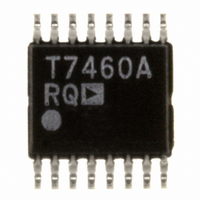ADT7460ARQ ON Semiconductor, ADT7460ARQ Datasheet - Page 26

ADT7460ARQ
Manufacturer Part Number
ADT7460ARQ
Description
IC REMOTE THRML/FAN CTRLR 16QSOP
Manufacturer
ON Semiconductor
Series
dBCool®r
Datasheet
1.ADT7460ARQ.pdf
(52 pages)
Specifications of ADT7460ARQ
Rohs Status
RoHS non-compliant
Function
Fan Control, Temp Monitor
Topology
ADC, Comparator, Multiplexer, Register Bank
Sensor Type
External & Internal
Sensing Temperature
-40°C ~ 120°C, External Sensor
Output Type
SMBus™
Output Alarm
No
Output Fan
Yes
Voltage - Supply
3 V ~ 5.5 V
Operating Temperature
-40°C ~ 120°C
Mounting Type
Surface Mount
Package / Case
16-QSOP
Available stocks
Company
Part Number
Manufacturer
Quantity
Price
Company:
Part Number:
ADT7460ARQ
Manufacturer:
AD
Quantity:
2 100
Part Number:
ADT7460ARQ
Manufacturer:
ADI/亚德诺
Quantity:
20 000
Company:
Part Number:
ADT7460ARQ-REEL
Manufacturer:
AD
Quantity:
5 000
Company:
Part Number:
ADT7460ARQ-REEL
Manufacturer:
ADI
Quantity:
297
Part Number:
ADT7460ARQ-REEL
Manufacturer:
ADI/亚德诺
Quantity:
20 000
Part Number:
ADT7460ARQZ
Manufacturer:
ADI/亚德诺
Quantity:
20 000
Company:
Part Number:
ADT7460ARQZ-REEL
Manufacturer:
ST
Quantity:
16
ADT7460
Configuring the Desired THERM Behavior
1.
2.
3.
4.
5.
Configure the THERM input.
Setting Bit 1 ( THERM ENABLE) of Configuration
Register 3 (Reg. 0x78) enables the THERM monitoring
function.
Select the desired fan behavior for THERM events.
Setting Bit 2 (BOOST bit) of Configuration Register 3
(Reg. 0x78) causes all fans to run at 100% duty cycle
whenever THERM is asserted. This allows fail-safe syst
cooling. If this bit = 0, the fans run at their current set
and are not affected by
Select whether THERM events should generate
SMBALERT interrupts.
Bit 5 (F4P) of Mask Register 2 (Reg. 0x75), when set, ma
out
This bit should be cleared if SMBALERT s based on THERM
events are required.
Select a suitable THERM limit value.
This value determines whether an SMBALERT is generated
on the first THERM assertion, or only if a cumulative
THERM assertion time limit is exceeded. A value of 0x00
causes an SMBALERT to be generated on the first THERM
assertion.
Select a THERM monitoring time.
This is how often OS or BIOS level software checks the
THERM timer. For example, BIOS could read the THERM
timer once an hour to determine the cumulative THERM
assertion time. If, for example, the total THERM assertion
time is <22.76 ms in Hour 1, >182.08 ms in Hour 2, and
>5.825 s in Hour 3, this can indicate that system perfor -
a
more frequently on an hourly basis.
Alternatively, OS or BIOS level software can time-stamp
when the system is powered on. If an SMBALERT is
generated due to the THERM limit being exceeded,
another time-stamp can be taken. The difference in time
can be calculated for a fixed THERM limit time. For
example, if it takes one week for a THERM limit o
to be exceeded and the next time it takes only one hour,
this indicates a serious degradation in system performance.
nce is degrading significantly since THERM is asserting
SMBALERT s when the THERM limit value is exceeded.
THERM events.
f 2.914 s
tings
m
em
Rev. C | Page 26 of 52
sks
Configuring the ADT7460 THERM Pin as an Output
In addition to the ADT7460 being able to monitor THERM as
an input, the ADT7460 can optionally drive THERM low as a
output. The user can preprogram system critical thermal limi
If the temperature exceeds a thermal limit by 0.25°C,
asserts low. If the temperature is still a
the next monitoring cycle, THERM stays low. THERM remains
asserted low until the temperature is equal to or below the
thermal limit. Since the temperature for that channel is measured
only every monitoring cycle, on
teed to remain low for at least one monitoring cycle.
The THERM pin can be configured to assert low if the Remote 1,
local, or Remote 2 temperature THERM limits are exceeded by
0.25°C. The THERM limit registers are at Locations 0x6A,
0x6B, and 0x6C, respectively. Setting Bit 3 of Registers 0x5F,
0x60, and 0x61 enables the THERM output feature for the
Remote 1, local, and Remote 2 temperature channels, respectively.
Figure 40 shows how the THERM pin asserts low as an output
in the event of a critical overtemperature.
Figure 40. Asserting
THERM
THERM LIMIT
THERM LIMIT
0.25°C
TEMP
THERM as an Output, Based on Tripping THERM Limits
MONITORING
ADT7460
CYCLE
ce
THERM
bove the thermal limit on
asserts, it is guaran-
THERM
ts.
n











